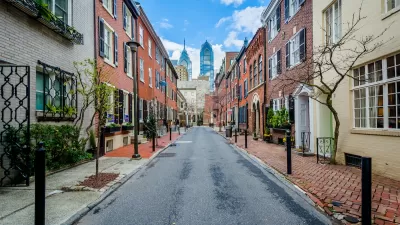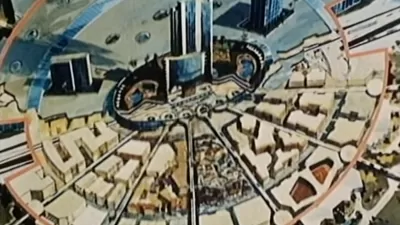"The secret of Disney is doing things you don't need, and doing them well, and realizing that you needed them all along...Walt Disney was ahead of everyone, always." -Isaac Asimov, interviewed by Leonard Maltin
"The secret of Disney is doing things you don't need, and doing them
well, and realizing that you needed them all along...Walt Disney was
ahead of everyone, always."
-Isaac Asimov, interviewed by Leonard Maltin
 Among my friends and colleagues, I tend to get pegged as the Disney guy. That's fair -
Among my friends and colleagues, I tend to get pegged as the Disney guy. That's fair -
I have an undeniable obsession with Walt and his team of Imagineers,
and the unique creations they brought into being. There are obvious
reasons- the Disney approach to theming and attention to detail are
responsible for fascinating built environments. And in the years before
his death, he got obsessed with urban planning and put plans in motion
to build an Experimental Prototype Community of Tomorrow (EPCOT), a
planned technotopia that would house 20,000 people. So there is plenty
of fodder for someone interested in architecture, planning and public
space to chew on.
But after obsessing over Walt's futurism and vision for years, I've been asking myself, "Why? Why is this long-dead animator still as
interesting to me as more rigorous urbanists like Jane Jacobs or Jan
Gehl?" In truth, his vision for EPCOT was naive, and was a fairly uncomplicated
take on Ebenezer Howard's garden plan. And I would find a downtown Imagineered down to the minute details oppressive.
What was unique about Walt Disney, I've concluded - and
is lacking in so much of today's world - is the combination of vision, craft, and cash.
As planners (if we're lucky) we get to create plans for
neighborhoods and downtowns that lay out a vision for development that
is forward-thinking while simultaneously building on the history and character
of a place. But we know that developers are truly responsible for what
gets built - we can't dictate if a building houses a wonderful store
with local character or a Cash for Gold store (the unfortunate new
tenant of a new mixed-use project I pass every day). We can have local
design standards and commissions, but we can't stop a developer from
creating a cheap plastic knockoff of an historic lintel. We're reliant, for the most part, on what comes in the door.
Meanwhile, developers aren't without the desire to build developments
that people will love, and will last. But they often lack vision, or the
knowledge and experience, that planners have developed. Managing architects and the daily business of construction takes its own sort of expertise, so its not surprising that developers have a different focus. And while they have the ability to pull cash
together, their loan providers are often skittish of anything unproven
and prefer to see projects that are familiar models - even as the market
is rapidly changing its preferences.
When I look at 90% of today's new developments, I can't help but get the feeling that the developer is trying to meet the vision that local planners have laid out but they don't really FEEL it. We're getting new multi-family, 4-6 story, mixed-use TOD, but there's a cookie-cutter feeling to most. Like the infamous "little boxes" of suburbia, most of these new multi-family constructions feel of a type, like they were pressed through a Play-Doh mold. I'm not saying the building below is especially terrible, but where is it? I swear I've seen this exact same building in several cities.

And that's what is so remarkable about Walt Disney. He was the ultimate developer: he had unique visions, he wouldn't compromise on bringing those visions to reality, and he wasn't afraid to spend the money to do it. He was often on the edge of bankruptcy because he would pour not only his heart and soul into every project but also every cent he had. He understood how to manage and inspire craftspeople and designers to build to his specifications. And while we're now in the post-Robert Moses world where community input is an imperative, I can't help but think that Walt knew how to sell a project and would win any NIMBY over to his side.
So where are the visionary developers of today?
I call on the Planetizen readers to enlighten us and show us examples of great vision, new developments that are inspired and have heart. Size doesn't matter - the smallest building can be inspired. Can visionary development happen in the 21st century?

Planetizen Federal Action Tracker
A weekly monitor of how Trump’s orders and actions are impacting planners and planning in America.

San Francisco's School District Spent $105M To Build Affordable Housing for Teachers — And That's Just the Beginning
SFUSD joins a growing list of school districts using their land holdings to address housing affordability challenges faced by their own employees.

The Tiny, Adorable $7,000 Car Turning Japan Onto EVs
The single seat Mibot charges from a regular plug as quickly as an iPad, and is about half the price of an average EV.

Seattle's Plan for Adopting Driverless Cars
Equity, safety, accessibility and affordability are front of mind as the city prepares for robotaxis and other autonomous vehicles.

As Trump Phases Out FEMA, Is It Time to Flee the Floodplains?
With less federal funding available for disaster relief efforts, the need to relocate at-risk communities is more urgent than ever.

With Protected Lanes, 460% More People Commute by Bike
For those needing more ammo, more data proving what we already knew is here.
Urban Design for Planners 1: Software Tools
This six-course series explores essential urban design concepts using open source software and equips planners with the tools they need to participate fully in the urban design process.
Planning for Universal Design
Learn the tools for implementing Universal Design in planning regulations.
Smith Gee Studio
City of Charlotte
City of Camden Redevelopment Agency
City of Astoria
Transportation Research & Education Center (TREC) at Portland State University
US High Speed Rail Association
City of Camden Redevelopment Agency
Municipality of Princeton (NJ)





























